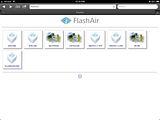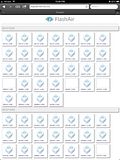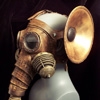Wow, amazing that someone actually answers customers these days.Darth Vader Face wrote:Transcend responded quickly! But it looks like this idea is a no-go:
Has anyone tried a *wifi SD card* with their ResMed?
Re: Has anyone tried a *wifi SD card* with their ResMed?
_________________
| Mask: Swift™ FX Nasal Pillow CPAP Mask with Headgear |
| Humidifier: S9™ Series H5i™ Heated Humidifier with Climate Control |
| Additional Comments: Also SleepyHead, PRS1 Auto, Respironics Auto M series, Legacy Auto, and Legacy Plus |
Please enter your equipment in your profile so we can help you.
Click here for information on the most common alternative to CPAP.
If it's midnight and a DME tells you it's dark outside, go and check for yourself.
Useful Links.
Click here for information on the most common alternative to CPAP.
If it's midnight and a DME tells you it's dark outside, go and check for yourself.
Useful Links.
Re: Has anyone tried a *wifi SD card* with their ResMed?
I ordered a FlashAir card from Buy.com to play with. Don't know if I will keep it, but it will be fun to learn how it works in the S9s. I'll provide a review in a couple of weeks and let everyone know my thoughts.
_________________
| Mask: AirFit™ F10 Full Face Mask with Headgear |
| Humidifier: S9™ Series H5i™ Heated Humidifier with Climate Control |
| Additional Comments: Machine: S9 VPAP Adapt (eASV) 36037 |
Mode: ASVAuto, Min EPAP: 4, Max EPAP: 15, Min PS: 3, Max PS: 15, Ramp: Off - Original Titration: 18
Re: Has anyone tried a *wifi SD card* with their ResMed?
Don't have any idea why they don't have wireless built into these high-tech, computer-driven things these days. Trivial to do, and if it doesn't work due to some configuration problem or wireless isn't available, you always have the SD card for hard backup.
Bunch of Luddite manufacturers...
Bunch of Luddite manufacturers...
_________________
| Machine: ResMed AirSense™ 10 AutoSet™ CPAP Machine with HumidAir™ Heated Humidifier |
| Mask: ResMed AirFit N30 Nasal CPAP Mask with Headgear |
ResMed AirSense 10 Autoset
Philips Respironics Dreamwear nasal mask
Philips Respironics Dreamwear nasal mask
- Darth Vader Face
- Posts: 19
- Joined: Sun Dec 16, 2012 4:51 pm
Re: Has anyone tried a *wifi SD card* with their ResMed?
The nice thing about NOT having wireless is that it isn't going to get remotely hacked or corrupted. It is a medical device, so keeping the security as simple as just physical security (access to the control panel) is probably a plus.RogerSC wrote:Don't have any idea why they don't have wireless built into these high-tech, computer-driven things these days. Trivial to do, and if it doesn't work due to some configuration problem or wireless isn't available, you always have the SD card for hard backup.
Still, I'm eager to know how well the FlashAir card works. Even if it provides limited access to files, it will at least let us know how the power aspect of it works. This isn't a mobile device, and energy efficiency isn't at a premium, so you'd think that the SD slot would be constantly powered. But you never know.
_________________
| Mask: Mirage Quattro™ Full Face CPAP Mask with Headgear |
| Humidifier: S9™ Series H5i™ Heated Humidifier with Climate Control |
| Additional Comments: Software: ResScan 4.01.013 and SleepyHead 0.9.2-1 |
Re: Has anyone tried a *wifi SD card* with their ResMed?
I tried a wifi SD card for camera use.... I DID NOT like it at all.!
I returned it and went back to normal SD/SDHC/SDXC cards.
One problem I found was hassle/lack of control when and where not to mention upload to. Every time I near a wifi hot spot it wanted to upload my photos, even places I DID NOT want my data uploaded to.
I returned it and went back to normal SD/SDHC/SDXC cards.
One problem I found was hassle/lack of control when and where not to mention upload to. Every time I near a wifi hot spot it wanted to upload my photos, even places I DID NOT want my data uploaded to.
_________________
| Mask: Quattro™ FX Full Face CPAP Mask with Headgear |
| Additional Comments: APAP Rx 10-14 actual use range 10+ to 13+ |
Re: Has anyone tried a *wifi SD card* with their ResMed?
Could be done using encryption, so it privacy wouldn't be an issue. There are also ways of detecting corruption...and again, you'd also have the card for backup if you needed it. I'd love to see wireless be available, obviously *smile*.Darth Vader Face wrote:The nice thing about NOT having wireless is that it isn't going to get remotely hacked or corrupted. It is a medical device, so keeping the security as simple as just physical security (access to the control panel) is probably a plus.RogerSC wrote:Don't have any idea why they don't have wireless built into these high-tech, computer-driven things these days. Trivial to do, and if it doesn't work due to some configuration problem or wireless isn't available, you always have the SD card for hard backup.
Still, I'm eager to know how well the FlashAir card works. Even if it provides limited access to files, it will at least let us know how the power aspect of it works. This isn't a mobile device, and energy efficiency isn't at a premium, so you'd think that the SD slot would be constantly powered. But you never know.
_________________
| Machine: ResMed AirSense™ 10 AutoSet™ CPAP Machine with HumidAir™ Heated Humidifier |
| Mask: ResMed AirFit N30 Nasal CPAP Mask with Headgear |
ResMed AirSense 10 Autoset
Philips Respironics Dreamwear nasal mask
Philips Respironics Dreamwear nasal mask
Re: Has anyone tried a *wifi SD card* with their ResMed?
the K.I.S.S principle ain't bad...in my book.
KISS = Keep It Super Simple, aka Keep It Simple Stupid (your choice)
KISS = Keep It Super Simple, aka Keep It Simple Stupid (your choice)
_________________
| Mask: Quattro™ FX Full Face CPAP Mask with Headgear |
| Additional Comments: APAP Rx 10-14 actual use range 10+ to 13+ |
Update: Toshiba FlashAir
I have received the FlashAir card and done some initial playing with the device. I have to admit it is amazing what they can do in the small space of an SD card with putting a WIFI system in there.
In the documentation of the FlashAir card it warns you not to format the card with a computer because the files on the card are necessary to make the WIFI system work. I found that interesting but continued by making an image of the FlashAir card and an image of my ResMed card as backups prior to playing. I left the FlashAir files intact and added my existing ResMed files on the FlashAir card in the same file structure as they existed on the ResMed card. Upon inserting it in the S9 I received the SD card not recognized error. My initial guess is that the ResMed machine wants only its files to exist on the card. I will do some more playing at a later time prior to returning the card. I can think of two other tests. But it appears this is not a solution.
Future tests will be adding any small file to ResMed card to see if the addition renders the card useless. If it does then the FlashAir solution can not work no matter what is done. If however I can add files, I may allow the S9 to format the FlashAir card so that it is happy, then copy the FlashAir files back to the card.
Assuming the above roadblocks could be overcome it appears that the FlashAir system only allows the card to work as a server for 5 minutes after providing the card with power. This timer is variable in settings from 1 to 10 minutes. This would mean that power to the card would need to be interrupted to start over that timer and access the card. This may not be a factor since the S9 most likely drops power to the SD card upon going into standby mode between sessions, but this theory would need to be tested.
In the documentation of the FlashAir card it warns you not to format the card with a computer because the files on the card are necessary to make the WIFI system work. I found that interesting but continued by making an image of the FlashAir card and an image of my ResMed card as backups prior to playing. I left the FlashAir files intact and added my existing ResMed files on the FlashAir card in the same file structure as they existed on the ResMed card. Upon inserting it in the S9 I received the SD card not recognized error. My initial guess is that the ResMed machine wants only its files to exist on the card. I will do some more playing at a later time prior to returning the card. I can think of two other tests. But it appears this is not a solution.
Future tests will be adding any small file to ResMed card to see if the addition renders the card useless. If it does then the FlashAir solution can not work no matter what is done. If however I can add files, I may allow the S9 to format the FlashAir card so that it is happy, then copy the FlashAir files back to the card.
Assuming the above roadblocks could be overcome it appears that the FlashAir system only allows the card to work as a server for 5 minutes after providing the card with power. This timer is variable in settings from 1 to 10 minutes. This would mean that power to the card would need to be interrupted to start over that timer and access the card. This may not be a factor since the S9 most likely drops power to the SD card upon going into standby mode between sessions, but this theory would need to be tested.
_________________
| Mask: AirFit™ F10 Full Face Mask with Headgear |
| Humidifier: S9™ Series H5i™ Heated Humidifier with Climate Control |
| Additional Comments: Machine: S9 VPAP Adapt (eASV) 36037 |
Mode: ASVAuto, Min EPAP: 4, Max EPAP: 15, Min PS: 3, Max PS: 15, Ramp: Off - Original Titration: 18
Re: Update: Toshiba FlashAir
How do you access the FlashAir card? Through a web site on the internet, as another computer on your network, through a special program on your PC, etc.?
Try copying the Datalog directory onto the FlashAir card and then put it into a camera and see if you can read the files in the datalog directory.
Try copying the Datalog directory onto the FlashAir card and then put it into a camera and see if you can read the files in the datalog directory.
_________________
| Mask: Swift™ FX Nasal Pillow CPAP Mask with Headgear |
| Humidifier: S9™ Series H5i™ Heated Humidifier with Climate Control |
| Additional Comments: Also SleepyHead, PRS1 Auto, Respironics Auto M series, Legacy Auto, and Legacy Plus |
Please enter your equipment in your profile so we can help you.
Click here for information on the most common alternative to CPAP.
If it's midnight and a DME tells you it's dark outside, go and check for yourself.
Useful Links.
Click here for information on the most common alternative to CPAP.
If it's midnight and a DME tells you it's dark outside, go and check for yourself.
Useful Links.
Re: Update: Toshiba FlashAir
Special applications on the PC or Mac are not necessary unless you want to change the default configuration of the cards features. The Flashair card has a SSID and Password configuration to connect to using any WIFI device. A web browser is then used to select files to download from the root level of the card. In the below example I have used Safari on an iPad to access the contents browsing to flashair/ in the browser.archangle wrote:How do you access the FlashAir card? Through a web site on the internet, as another computer on your network, through a special program on your PC, etc.?
Try copying the Datalog directory onto the FlashAir card and then put it into a camera and see if you can read the files in the datalog directory.

As requested my datalog directory

(Click images for larger view)
_________________
| Mask: AirFit™ F10 Full Face Mask with Headgear |
| Humidifier: S9™ Series H5i™ Heated Humidifier with Climate Control |
| Additional Comments: Machine: S9 VPAP Adapt (eASV) 36037 |
Mode: ASVAuto, Min EPAP: 4, Max EPAP: 15, Min PS: 3, Max PS: 15, Ramp: Off - Original Titration: 18
Re: Has anyone tried a *wifi SD card* with their ResMed?
OK, so if you had a home PC with a wireless router, it wouldn't connect to the router. You'd need to configure your PC to disconnect from the router then connect to the FlashAir card directly, then restore your PC connection back to the wireless router when though.
Or will the FlashAir card connect to a wireless router, become part of your home network, and let you access it that way?
It's good to see that the card will allow you to access non-picture files.
I bet it would work in a PRS1 machine. They don't do the brainless things ResMed does in terms of non-standard files on the SD card.
Or will the FlashAir card connect to a wireless router, become part of your home network, and let you access it that way?
It's good to see that the card will allow you to access non-picture files.
I bet it would work in a PRS1 machine. They don't do the brainless things ResMed does in terms of non-standard files on the SD card.
_________________
| Mask: Swift™ FX Nasal Pillow CPAP Mask with Headgear |
| Humidifier: S9™ Series H5i™ Heated Humidifier with Climate Control |
| Additional Comments: Also SleepyHead, PRS1 Auto, Respironics Auto M series, Legacy Auto, and Legacy Plus |
Please enter your equipment in your profile so we can help you.
Click here for information on the most common alternative to CPAP.
If it's midnight and a DME tells you it's dark outside, go and check for yourself.
Useful Links.
Click here for information on the most common alternative to CPAP.
If it's midnight and a DME tells you it's dark outside, go and check for yourself.
Useful Links.
- Sir NoddinOff
- Posts: 4190
- Joined: Mon May 14, 2012 5:30 pm
- Location: California
Re: Has anyone tried a *wifi SD card* with their ResMed?
Whew the travails of WIFI. I tried it once and it didn't work for me, as others have indicated. I did lose my PR supplied SD card once, so I how have a 2" diameter white sauce bowl sitting on the table next to my couch. It's a little dipping bowl used for cocktail sauce etc. When I load my data card into my laptop I put the dummy card in the sauce bowl (cards are all that ever goes into it). When SH pulls my sleep data off the real card, I immediately put the dummy back in the card slot, then I drop the real card into the white sauce bowl. Since it's right next to my coffee cup, I always see the black card in the saucer, plus it's relatively safe and hard to lose in there. Eventually it ends up back in the PR S1 where it belongs. Simple but fairly bulletproof. Also, I'm in the habit of reaching behind the machine and feeling to see if the SD card is in there before masking up. While I'm at it, I check to make sure filter didn't fall out. Man, there's so much involved with this CPAP stuff.
_________________
| Mask: AirFit™ F10 Full Face Mask with Headgear |
| Additional Comments: Sleepyhead software v.0.9.8.1 Open GL and Encore Pro v2.2. |
I like my ResMed AirFit F10 FFM - reasonably low leaks for my ASV therapy. I'm currently using a PR S1 AutoSV 960P Advanced. I also keep a ResMed S9 Adapt as backup. I use a heated Hibernite hose. Still rockin' with Win 7 by using GWX to stop Win 10.
Re: Has anyone tried a *wifi SD card* with their ResMed?
How about attempting to receive the data from the modem attached to some of our machines?
Has anyone tried or considered that?
Just curious.
Nate
Has anyone tried or considered that?
Just curious.
Nate
_________________
| Mask: DreamWear Nasal CPAP Mask with Headgear |
| Additional Comments: ResMed AirCurve 10 ASV; Dreamwear Nasal Mask Original; CPAPMax Pillow; ResScan & SleepyHead |
Central sleep apnea AHI 62.6 pre-VPAP. Now 0 to 1.3
Present Rx: EPAP: 8; IPAPlo:11; IPAPHi: 23; PSMin: 3; PSMax: 15
"I've had a perfectly wonderful evening, but this wasn't it." —Groucho Marx
Present Rx: EPAP: 8; IPAPlo:11; IPAPHi: 23; PSMin: 3; PSMax: 15
"I've had a perfectly wonderful evening, but this wasn't it." —Groucho Marx
Re: Update: Toshiba FlashAir
It's been awhile since I messed around with the S9 SD card and files, but as you found out the S9 is very particular about how the card is formatted. If I remember correctly there is a directory entry for a journal.dat file. The start cluster for that file is near the end of the card data range. I don't know if the journal.dat file actually exists or not, but the directory entry has to be there and point to a specific place on the card. It's almost impossible to duplicate that entry even with a disk editior like WinHex. And, it may be a calculated figure based on who knows what parameters, kind of like the CRC files. That's all part of Resmed's approach to ensure data integrity from machine to Resscan. Resscan will read an SD card that has had the files written to it with Windows Explorer, but don't change anything about the edf files or the CRC won't match because Resscan does check those.STL Mark wrote:Upon inserting it in the S9 I received the SD card not recognized error. My initial guess is that the ResMed machine wants only its files to exist on the card. I will do some more playing at a later time prior to returning the card. I can think of two other tests. But it appears this is not a solution.
From what Mac users have said, the S9 won't accept a card that has a strange file added to it like what an iBook wants to put on it.
I'd say the idea of using the FlashAir card in an S9 is a non starter.
_________________
| Mask: AirFit™ P10 Nasal Pillow CPAP Mask with Headgear |
| Humidifier: S9™ Series H5i™ Heated Humidifier with Climate Control |
| Additional Comments: Hose management - rubber band tied to casement window crank handle! Hey, it works! S/W is 3.13, not 3.7 |
Re: Has anyone tried a *wifi SD card* with their ResMed?
I believe the modem transmits only summary data.NateS wrote:How about attempting to receive the data from the modem attached to some of our machines?
Has anyone tried or considered that?
Just curious.
Nate
_________________
| Mask: AirFit™ P10 Nasal Pillow CPAP Mask with Headgear |
| Humidifier: S9™ Series H5i™ Heated Humidifier with Climate Control |
| Additional Comments: Hose management - rubber band tied to casement window crank handle! Hey, it works! S/W is 3.13, not 3.7 |














